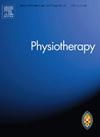抗药研究(脊髓性肌萎缩患者的呼吸肌训练):一项随机对照试验的结果
IF 3
3区 医学
Q1 REHABILITATION
引用次数: 0
摘要
目的探讨呼吸肌训练(RMT)治疗脊髓性肌萎缩症(SMA)伴呼吸肌无力的疗效和可行性。DesignA 4个月的单盲随机对照试验,随后是8个月的延长期。荷兰乌得勒支大学医学中心神经内科和儿童发展与运动中心门诊。参与者:30名参与者,年龄≥8岁,SMA 1 - 4型,呼吸肌无力。干预措施:训练组在最大吸气压(PImax)和最大呼气压(PEmax)的30%时开始RMT,并根据感知到的用力调整训练强度。对照组开始并继续以10%的哌甲哌啶和哌甲哌啶进行RMT治疗。四个月后,对照组接受与训练组相同的RMT。主要结局指标:主要结局指标为RCT期后PImax的组间差异。此外,我们探讨了训练量(即训练次数x训练强度)与1年内PImax增加之间的关系。结果25名参与者完成了研究。4个月后平均PImax(校正基线值)训练组:61.1 cmH2O,对照组:54.3 cmH2O,平均PImax差异:6.8 cmH2O [95% CI:−2.0至15.6]。尽管这项研究的效力不足,但我们确实发现训练量与PImax增加之间存在关联(R2 = 0.531)。结论RCT期结束后,PImax组间差异较小。培训是安全的,但培训的可行性有待进一步提高。临床试验注册号:bernl73280.041.20。•在不同强度的训练中,PImax的改善有微小的差异(10% vs 30%的PImax)。•更高的训练量(频率乘以强度)与吸气肌力量的改善有关。•监督(由物理治疗师)可能有助于更好地坚持呼吸肌训练。本文章由计算机程序翻译,如有差异,请以英文原文为准。
The RESISTANT study (Respiratory Muscle Training in Patients with Spinal Muscular Atrophy): results of a randomized controlled trial
Objectives
To investigate the efficacy and feasibility of respiratory muscle training (RMT) in patients with spinal muscular atrophy (SMA) and respiratory muscle weakness.
Design
A 4-month, single-blinded RCT, followed by an 8-month extension phase.
Setting
The outpatient clinic of the Neurology department and the Child Development and Exercise Center at the University Medical Center Utrecht, The Netherlands.
Participants
30 participants, ≥eight years, SMA type 1 to 4, and respiratory muscle weakness.
Interventions
The training group started RMT at 30% of their maximum inspiratory (PImax) and expiratory pressure (PEmax) and adjusted their training intensity based on perceived exertion. The control group started and continued RMT at 10% of PImax and PEmax. After four months, the control group received the same RMT as the training group.
Main outcome measures
The primary outcome was the between-group difference in PImax after the RCT phase. Additionally, we explored the association between training volume (i.e., number of training sessions x training intensity) and increase in PImax over 1 year.
Results
25 participants completed the study. Mean PImax after four months (corrected for baseline value) training group: 61.1 cmH2O, control group: 54.3 cmH2O, mean difference in PImax: 6.8 cmH2O [95% CI: −2.0 to 15.6]. Despite the study being underpowered, we did find an association between training volume and increase in PImax (R2 = 0.531).
Conclusion
There was a small between-group difference in PImax after the RCT phase. The training was safe, but the feasibility of the training needs further improvement.
Clinical Trial Registration Number
NL73280.041.20.
Contribution of the Paper
- •There was a small difference in PImax improvement between training at different intensities (10% vs 30% of PImax).
- •Higher training volume (frequency times intensity) is associated with improvement of inspiratory muscle strength.
- •Supervision (by physiotherapists) might contribute to better adherence to respiratory muscle training.
求助全文
通过发布文献求助,成功后即可免费获取论文全文。
去求助
来源期刊

Physiotherapy
医学-康复医学
CiteScore
6.40
自引率
3.00%
发文量
377
审稿时长
82 days
期刊介绍:
Physiotherapy aims to publish original research and facilitate continuing professional development for physiotherapists and other health professions worldwide. Dedicated to the advancement of physiotherapy through publication of research and scholarly work concerned with, but not limited to, its scientific basis and clinical application, education of practitioners, management of services and policy.
We are pleased to receive articles reporting original scientific research, systematic reviews or meta-analyses, theoretical or debate articles, brief reports and technical reports. All papers should demonstrate methodological rigour.
 求助内容:
求助内容: 应助结果提醒方式:
应助结果提醒方式:


